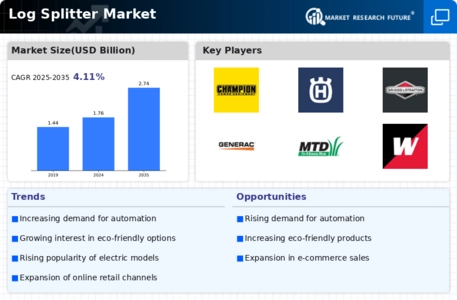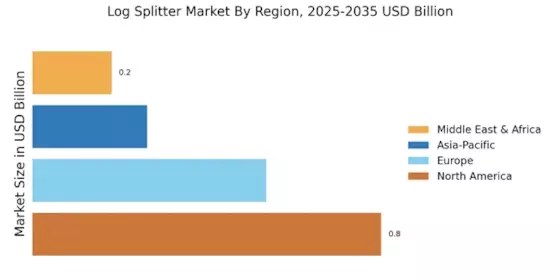Rising Popularity of Outdoor Activities
The Log Splitter Market is benefiting from the increasing popularity of outdoor activities, particularly among homeowners who engage in gardening, landscaping, and recreational wood processing. As more individuals invest in outdoor living spaces, the demand for firewood and wood-based products has surged. This trend is reflected in market data, which shows a steady increase in sales of log splitters, particularly during the peak seasons of spring and fall. Additionally, the rise of DIY culture has encouraged consumers to purchase log splitters for personal use, further driving market growth. The Log Splitter Market is poised to capitalize on this trend, as more people seek to enhance their outdoor experiences with efficient wood processing solutions.
Growth of E-commerce and Online Retailing
The Log Splitter Market is significantly influenced by the growth of e-commerce and online retailing, which has transformed the way consumers purchase equipment. With the increasing prevalence of online shopping, consumers now have access to a wider range of log splitter options, often at competitive prices. Data suggests that online sales of log splitters have increased by approximately 25% in recent years, as consumers appreciate the convenience and variety offered by e-commerce platforms. This trend is expected to continue, as more manufacturers and retailers enhance their online presence. The Log Splitter Market stands to benefit from this shift, as the accessibility of products through online channels may lead to increased sales and market penetration.
Increasing Demand for Sustainable Practices
The Log Splitter Market is witnessing a notable shift towards sustainable practices, driven by a growing awareness of environmental issues. Consumers are increasingly opting for wood as a renewable energy source, which has led to a rise in demand for log splitters. This trend is further supported by government initiatives promoting the use of renewable energy, which encourages homeowners and businesses to invest in efficient wood processing equipment. As a result, the market for log splitters is projected to expand, with estimates suggesting a compound annual growth rate of around 5% over the next few years. This increasing demand for sustainable practices is likely to propel the Log Splitter Market forward, as more individuals seek eco-friendly solutions for their heating and energy needs.
Technological Advancements in Log Splitters
Technological innovations are significantly influencing the Log Splitter Market, as manufacturers are increasingly integrating advanced features into their products. The introduction of hydraulic and electric log splitters has enhanced efficiency and ease of use, appealing to both professional and amateur users. Data indicates that electric log splitters are gaining traction, accounting for approximately 30% of the market share due to their low emissions and reduced noise levels. Furthermore, the incorporation of smart technology, such as automated controls and safety features, is expected to attract a broader customer base. As these advancements continue to evolve, the Log Splitter Market is likely to experience substantial growth, driven by consumer demand for high-performance and user-friendly equipment.
Expansion of the Construction and Landscaping Sectors
The Log Splitter Market is experiencing growth due to the expansion of the construction and landscaping sectors. As urbanization continues to rise, there is an increasing demand for landscaping services, which often require the use of log splitters for efficient wood processing. Market analysis indicates that the construction industry is projected to grow at a rate of 4% annually, leading to a higher demand for log splitters among contractors and landscapers. This growth is further supported by the trend of incorporating natural wood elements into modern architecture and landscaping designs. Consequently, the Log Splitter Market is likely to see a surge in sales as professionals seek reliable and efficient equipment to meet the demands of their projects.


















Leave a Comment